#Thompson Park Conservation Area
Explore tagged Tumblr posts
Text
My Relationship With Nature
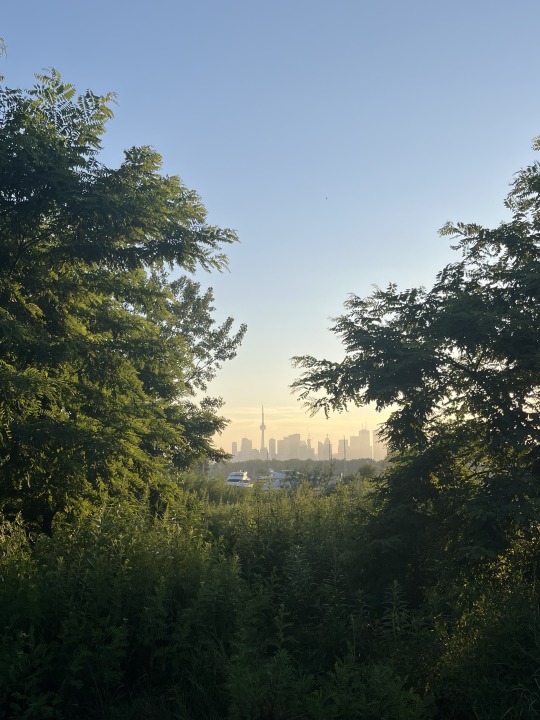
My current relationship with nature has strengthened extremely as I’ve found a lot of serenity and peace in the outdoors. I say strengthened since I’ve spent much more time in nature this past summer than in previous summers. I was born and raised in Toronto (actually downtown and not like Pickering). As a kid, I spent a lot of time biking and exploring various parks such as Tommy Thompson Park, Evergreen Brickworks and the small area of forestry near Riverdale Park. When I turned 16 I visited my uncle in British Columbia and was shocked to see the difference between the skyline of Whistler and Toronto. My experience in British Columbia was filled with tons of hikes and visiting various parks. This past summer my friends and I visited a few conservation parks in Southern Ontario including Mount Nemo and Laurel Creek Conservation Area. Seeing conservation parks was extremely eye-opening as the nature fix I got as a kid was extremely limited. Spending time in these isolated parks made me feel more connected to myself as the drastic change in noise in the city compared to a hiking trail gave me a lot of personal reflection time and allowed me to find a form of escapism. The time I spent on these hikes gave me time to slow down and enjoy my surroundings instead of worrying about getting from point A to B quickly.
Although my relationship with nature has strengthened a lot compared to before, I’ve only experienced and seen such a small portion of nature in Ontario, leaving me with so much more to explore. I’m excited to grow and experience more of the outdoors, especially when it comes to seeing more not just in Ontario but worldwide. The picture above was taken on the path at Tommy Thompson Park. I thought this picture depicted a good portion of my childhood as a majority of it was spent in the city until recently when I began spending more time in the outdoors. When it comes to a sense of place in nature, I’d say my mom was the person who gave it to me. She would always tell me stories of her life before moving to Canada and the scenery in Sri Lanka. She’d always stress the importance of enjoying nature and not taking it for granted especially when considering the effects of climate change. I’d spend a lot of time at Evergreen Brickworks with my mom and we would walk through the trails often and that got my love for being in the outdoors started early. I’ve taken a few courses on climate change so I’m also aware that I need to explore more sooner rather than later as the effects of climate change worsen which is why I see my relationship with nature only getting stronger as I mature. I only see my life getting more hectic as I get older meaning I’m going to need to make sure I have downtime to relax.
1 note
·
View note
Text
A Guide to Kenya's Rift Valley Sanctuary
Nestled amidst the picturesque landscapes of Kenya's Great Rift Valley, Lake Naivasha is renowned for its diverse wildlife and scenic beauty. From majestic mammals to colorful birdlife, the lake and its surrounding habitats offer ample opportunities for wildlife enthusiasts to observe and appreciate nature's wonders. Here's a guide to the wildlife you can spot at Lake Naivasha:
1. Hippos: Lake Naivasha is famous for its large population of hippos, which can often be seen lounging in the shallows or grazing along the lakeshore. Boat safaris provide excellent opportunities to observe these semi-aquatic mammals in their natural habitat, often accompanied by informative commentary from knowledgeable guides.

2. African Fish Eagles: One of the iconic bird species of Lake Naivasha is the African fish eagle, known for its distinctive call and impressive hunting skills. These majestic birds can be spotted perched on trees overlooking the lake, or soaring through the sky in search of fish, their primary prey.

3. Waterfowl and Migratory Birds: Lake Naivasha's wetlands and shores attract a rich variety of waterfowl and migratory birds throughout the year. Look out for species such as pelicans, herons, cormorants, and storks, which gather in large numbers to feed and roost in the lake's tranquil waters and surrounding marshlands.

4. Giraffes: Crescent Island, a sanctuary located on Lake Naivasha, is home to a population of Rothschild's giraffes. Visitors can enjoy a unique walking safari experience among these graceful giants, observing their behavior and interactions in a natural environment free from predators.
5. Zebras and Antelopes: Crescent Island also hosts plains zebras, Thompson's gazelles, and other antelope species that roam freely across its grassy plains and acacia woodlands. Walking safaris offer close encounters with these herbivores, providing opportunities for photography and wildlife observation up close.

6. Buffalo and Wildebeest: Occasionally, Cape buffaloes and wildebeests can be seen grazing on the shores of Lake Naivasha or in nearby grasslands. These large mammals are often spotted during boat safaris or while exploring the surrounding parks and conservancies in the Rift Valley region.
7. Monkeys and Baboons: Keep an eye out for troops of vervet monkeys and olive baboons that inhabit the forests and woodlands bordering Lake Naivasha. These agile primates are curious and social creatures, often seen foraging for food or interacting with each other in their natural habitat.

8. Reptiles and Amphibians: Lake Naivasha is home to a variety of reptiles and amphibians, including Nile monitor lizards, terrapins, and frogs. These species thrive in the lake's aquatic habitats and marshy areas, contributing to the region's biodiversity and ecological balance.
9. Birds of Prey: In addition to African fish eagles, Lake Naivasha supports a diverse array of birds of prey such as ospreys, marsh harriers, and owls. These raptors play a crucial role in the lake's ecosystem by controlling populations of small mammals and maintaining ecological equilibrium.
10. Insects and Butterflies: The diverse habitats around Lake Naivasha also support a variety of insects and butterflies, adding to the area's ecological richness. Look for colorful butterflies flitting among wildflowers and dragonflies hovering above the lake's surface, contributing to the natural beauty of this Rift Valley sanctuary.

#travel destinations#travel blog#across the spiderverse#asexual#donald trump#easter#barbie#artists on tumblr#africa#safari
0 notes
Text
Septic System Maintenance: Plumb Nerd's Tips

Introduction
Howdy, DIY warriors! Jack Thompson, your Plumb Nerd from Denver, is here to share some practical tips on septic system maintenance. If you're a proud septic system owner and want to keep everything flowing smoothly, you're in the right place. This guide is packed with straightforward advice to help you maintain a healthy septic system and avoid costly issues. Let's dive into the world of septic system care together.
Why Maintain Your Septic System?
Before we jump into the tips, let's quickly understand why maintaining your septic system is crucial: - Prevent System Failure: Regular maintenance prevents issues that can lead to septic system failure and expensive repairs. - Protect Groundwater Quality: Proper care ensures that your septic system doesn't contaminate groundwater, protecting the environment. - Extend System Lifespan: Routine maintenance can significantly extend the lifespan of your septic system.
Plumb Nerd's Tips
Here's your roadmap to becoming a septic system maintenance pro: 1. Regularly Pump the Tank Timing is everything: - How-to: Schedule regular septic tank pumping every 3-5 years, depending on household size and usage. - Why: Prevents sludge buildup, maintaining the tank's efficiency. 2. Be Water-Wise Conservation matters: - How-to: Fix leaks promptly, use water-efficient appliances, and spread out water usage to avoid overwhelming the system. - Why: Excessive water can overload the septic system. 3. Avoid Flushing Non-Biodegradable Items Mind your flush: - How-to: Only flush biodegradable items; avoid flushing non-degradable items like wipes, paper towels, or feminine hygiene products. - Why: Prevents clogs and minimizes strain on the system. 4. Use Septic-Safe Products Choose wisely: - How-to: Opt for septic-safe household products, including toilet paper, detergents, and cleaning agents. - Why: Harsh chemicals can disrupt the balance in the septic tank. 5. Be Cautious with Chemical Drain Cleaners Handle with care: - How-to: Avoid using chemical drain cleaners as they can harm the beneficial bacteria in the septic tank. - Why: Preserves the bacterial balance necessary for system function. 6. Direct Water Away from the Drainfield Mind your landscaping: - How-to: Ensure that rainwater and runoff are directed away from the septic drainfield. - Why: Prevents oversaturation of the drainfield, maintaining its effectiveness. 7. Plant Grass Over the Drainfield Green solution: - How-to: Plant grass over the drainfield to prevent soil erosion and promote optimal absorption. - Why: Grass helps with soil stability and absorption. 8. Avoid Parking or Heavy Structures Over the Drainfield Protect the ground: - How-to: Keep heavy vehicles, structures, or equipment away from the drainfield area. - Why: Prevents soil compaction and damage to the drainfield. 9. Inspect and Maintain the Distribution Box Check the junction: - How-to: Periodically inspect and maintain the septic system's distribution box for proper function. - Why: Ensures equal distribution of effluent to the drainfield. 10. Monitor Vegetation Near the Tank and Drainfield Watch your plants: - How-to: Avoid planting trees or shrubs with aggressive roots near the septic tank or drainfield. - Why: Prevents root intrusion and potential damage to the system. 11. Schedule Professional Inspections Expert eyes: - How-to: Periodically, hire a professional to inspect your septic system for signs of issues. - Why: Experts can detect problems early, preventing major repairs. 12. Educate Household Members Spread awareness: - How-to: Inform everyone in your household about septic system care and best practices. - Why: Encourages a collective effort to preserve the system.
Conclusion
There you have it, DIY champs! Tips for maintaining your septic system, delivered by Jack Thompson, your Plumb Nerd. If you ever need more DIY wisdom, head over to plumbnerd.com. Now, go keep that septic system in top-notch condition. Happy maintaining! Read the full article
0 notes
Text
Tourist Place in Kenya.
Kenya is a stunning country in East Africa known for its diverse landscapes, wildlife, and vibrant culture. There are numerous tourist attractions to explore in Kenya, ranging from national parks and wildlife reserves to cultural sites and beautiful coastal areas. Here are some of the top tourist places in Kenya:
Maasai Mara National Reserve: Famous for the annual wildebeest migration, Maasai Mara is one of Kenya's most iconic wildlife destinations. It offers excellent opportunities for game drives and wildlife photography. https://www.aecglobal.com.au/
Amboseli National Park: Known for its large herds of elephants and the stunning backdrop of Mount Kilimanjaro, Amboseli is a popular destination for wildlife enthusiasts and photographers.
Samburu National Reserve: Located in northern Kenya, Samburu is home to unique wildlife species like the reticulated giraffe, Grevy's zebra, and Beisa oryx. It's a great place for a safari experience.
Lake Nakuru National Park: Famous for its flamingos and rhino sanctuary, this park is a birdwatcher's paradise and offers opportunities to spot a variety of wildlife.
Tsavo National Parks (East and West): These two parks together form one of the largest wildlife conservation areas in the world. They offer diverse landscapes and wildlife viewing opportunities.
Nairobi National Park: Located just outside Kenya's capital city, Nairobi, this park allows you to see wildlife against the backdrop of the city skyline. It's home to lions, giraffes, and various other animals.
Mount Kenya: The country's highest peak offers trekking and mountaineering opportunities for those seeking adventure.
Lamu Island: This historic island off the Kenyan coast is known for its Swahili culture and beautiful beaches. Lamu Old Town is a UNESCO World Heritage Site.
Diani Beach: Located on the south coast of Kenya, Diani Beach is renowned for its white sandy beaches and crystal-clear waters, making it a popular destination for relaxation and water sports.
Great Rift Valley: This geological wonder offers stunning landscapes, including lakes like Naivasha, Elementaita, and Bogoria, each with its unique attractions.
Hells Gate National Park: Known for its geothermal activity and dramatic scenery, this park offers opportunities for hiking, rock climbing, and cycling.
Mombasa: Kenya's second-largest city is a cultural melting pot with historical sites like Fort Jesus, beautiful beaches, and vibrant markets.
Nairobi: The capital city has several attractions, including the Karen Blixen Museum, Nairobi National Museum, and the Giraffe Centre, where you can get up close to giraffes.
Thompson's Falls: Located in Nyahururu, these scenic waterfalls are a great stop for nature lovers and photographers.
Nairobi Animal Orphanage: This facility cares for orphaned and injured animals, providing an opportunity to see and learn about Kenya's wildlife up close.
Remember that Kenya's tourism offerings are diverse, catering to a wide range of interests, from safaris to cultural experiences and beach vacations. Be sure to check the latest travel advisories and entry requirements before planning your visit.
0 notes
Text






😇 Dream 😴 Living Starts Here! Unleash Your 👓Vision ...
👉 Welcome 🙏 to a slice of semi-rural tranquillity nestled in the dream location of 📌 #KahawaiPoint. This is a place where the harmony 👌 of nature meets modern living, a place where your dreams can turn into reality. Imagine owning a ☀️ freehold 567m2 (more or less) section, providing ample room to build your dream residence.
Picture your future 🏠 home, cleverly designed around two stunning 🌊 rivers, parks, conservation zones and wetlands. Depending on the elevation and orientation, you may enjoy breath-taking vistas of the surrounding landscapes or the nearby 🌸 natural features. As the area continues to flourish and develop, there is great potential for #capitalgrowth and return on #investment.
All essential 👍 utilities and services are readily available in the area, making the process of 🏗️ establishing your dream home both convenient and effortless.
⚡️Kahawai Point is situated along Auckland's Glenbrook 💦 Beach Peninsula meaning you will get to enjoy the best ✌️of both worlds - modern day living in beautiful coastal and rural surroundings. 🚶Take an easy stroll on a beautiful sunny morning along the walkways to the future waterfront ☕️ cafe that will be on offer in a perfectly designed spot to take advantage of the stunning views. An all tide boat ramp to enjoy 🚣♀️ watersports, fishing and just an overall 🌈 relaxing day is just down the road from your future home.
Hurry.. 🛎️ Don't delay to create your 🗝️ dream home in this unbeatable location. Take advantage of this opportunity, our vendor is looking for a 🔴 QUICK SALE. Call Ajay Gulati - Barfoot & Thompson NOW! 021 236 2008
#Section #BarfootandThompson Barfoot & Thompson Manukau #RealEstate #GULATI #OtohikawaAvenue #Glenbrook Ajay Gulati
0 notes
Text
Incumbent PC candidate Bloyce Thompson and NDP candidate Marian White are the only two candidates running in District 8: Stanhope-Marshfield, making it the only district on the Island with just two names on the ballot.
Thompson said he wasn't expecting to be running against just one other candidate.
"I was a little surprised, but I know it's a big commitment," he said. "A lot of people are surprised by it as well. But, you know, it's very positive there are two candidates on the ballot, so there is a choice."
White acknowledged it's a challenge taking on an incumbent but said Island New Democrats have already won by mounting a full slate of candidates this election.
"We're really making history here," she said. "I'm just shocked the other two parties didn't get the 27 candidates — I don't know what they've been doing for four years that they couldn't have come up with someone to put on a ballot. So my chances of winning? I think I've already won, but we'll know."
Stanhope-Marshfield is the only district left on the Island that can be considered a bellwether district, meaning the winning candidate there is always in the caucus of the winning party.
The district was realigned in 2019, absorbing the rural portions of former Tracadie-Hillsborough Park and York-Oyster Bed. Those districts were held by former Liberal premier Wade MacLauchlan and Liberal MLA Buck Watts.
In the last provincial election in 2019, Thompson defeated MacLauchlan — the sitting premier — with 39.5 percent of the vote.
But without a Liberal, Green, or Island Party candidate running this time, a vote against Dennis King's Progressive Conservative government in this district is a vote for the NDP.
"The challenge for me going up against one person and the incumbent is quite huge," White said.
"It's an opportunity for those Greens and the Liberals and others to lend me their vote if they want anyone but a Conservative … If you're not voting Tory, then come to me with your vote."
Thompson knows he won't have the advantage of multiple parties to split the vote for those who don't want to support the PCs, but says it hasn't changed how he's hitting the campaign trail. "I need 51 percent of the vote, but … we I've had some great conversations over the last couple of weeks," he said.
"We're gonna hit every door, talk to as many people as possible just to listen and hear what they have to say, and … I've got a great team around me, and it's full out."
Both candidates say they've heard similar issues out on the campaign trail. Health care is top of mind for many voters in the district, but so too are concerns around road safety and the loss of farmland in the area. "It's a bedroom community of Charlottetown almost, but we have all the three major industries — agriculture, fishing, and tourism, of course — so those three things are important," Thompson said.
"It's a growing community of those issues." But White said she's also heard from voters who weren't thrilled with the snap election call six months earlier than the fixed election date of October 2.
"People aren't with an election in the spring," she said. "Between frost and snow and mud, it's a terrible time for an election — unless you're the party in power and know for months in advance that you're calling a spring election."
Thompson said he and his rival she's a great candidate," he said. "The NDP seems to be organized and ready to go."
0 notes
Photo

Common Milkweed, Asclepias syriaca, by the side of a cornfield (by me)
#Common Milkweed#Asclepias syriaca#Asclepias#Asclepiadoideae#Apocynaceae#Gentianales#milkweed#plants#flowers#farmland#cornfield#summer#Thompson Park Conservation Area#Middlesex County#New Jersey#mine
28 notes
·
View notes
Text
Habitats don't forget themselves:
“Construction crews have been finding some seriously cool stuff while digging out a new mouth for the Don River in Toronto's Port Lands, but all of those old shoes and newspaper clippings from the 1800s pale in comparison to Waterfront Toronto's latest discovery: Brand new, very old plants.
"Over 100 years ago, fill was dumped into the biggest marsh in the Great Lakes to make the Port Lands. Now, we're digging that up to recreate a natural, marshy mouth for the Don River — and we discovered something surprising," reads a new post on the $1.25 billion Port Lands Flood Protection project's website.
....
It's been roughly five years since work began on what is being billed as "one of the largest waterfront revitalization projects in the world," and with every pound of soil removed Toronto comes one step closer to having a massive, brand new island with parks, housing, commercial and office space.
Villier's Island is expected to be complete by 2024, at which point the Don River will have been fully rerouted to protect the area from flooding (which is in fact the true impetus behind this massive undertaking.)
Progress on the river valley itself has been impressive, but excavating millions of cubic metres of old soil and gargbage takes time. While crews are working along at a clip, there's still dirt to remove and, apparently, treasures to uncover.
"In a low-lying section of the future river valley, construction crews noticed some unusual plants had sprung up out of nowhere. It's not uncommon to see plants on the site, but these plants caught their eye because they looked a lot like plants that grow in wetlands, not like the scrubby weeds that have popped up elsewhere," reads Waterfront Toronto's newest blog post, entitled "100-year-old seeds."
As it turns out, these plants were growing in an area that had been excavated about a year ago, some seven metres into the earth— deep enough to uncover the marsh's original soil without removing it.
"By chance, this area was relatively flat with poor drainage, and wasn't scheduled for further work for several months," reports Waterfront Toronto. "Over the summer the weather warmed up, water accumulated in the peaty soil, and more-than-century-old seeds sprang to life!"
It didn't take long for specialists to realize that these plants had grown from the historic marshland soil. Waterfront Toronto immediately reached out to the Toronto and Region Conservation Authority to relocate these precious new old plants and harvest any possible remaining seeds.
"We were able to identify at least two species of leafy plants that grew. Hard Stem Bulrush and Cattails were growing well, so we transplanted them to Tommy Thompson Park nearby," notes the blog post.
"The team also collected around 50 buckets of the surrounding soil, in the hopes that more seeds and species might germinate. We hope to know the results later in 2022."
Experts say it's pretty rare to find living plants that were around more than 100 years ago, and many are interested in studying the seeds. Waterfront Toronto says that a horticulturist at U of T is currently "overseeing the buckets of soil and conducting genetic tests on the plants."
"It's rare that you can compare a modern plant to a plant grown from pre-industrial seeds, so the discovery of these seeds was exciting," says Waterfront Toronto. "Only time will tell if plants adapted for the 1890s will be able to thrive in 2024 and beyond."”
- Lauren O’Neil, “Mysterious plants are sprouting from 100-year-old seeds at a Toronto excavation site,” BlogTO, April 21, 2022
#toronto#don river#port lands#waterfront toronto#marshland#marsh reclamation#flood control#hydrological engineering#flooding#marsh plants#beneath the paving stones the beach
12 notes
·
View notes
Photo


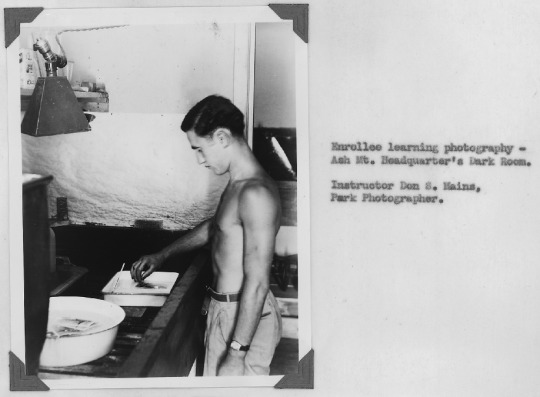

Report of activities at Sequoia National Park, by Superintendent John R. White [p. 1, 6-7], 9/8/1936
“The work of the CCC boys has been uninterrupted . . .”
File Unit: 207.02 [Monthly Narratives Sequoia], 1935 - 1940
Series: Central Files, 1925 - 1975
Record Group 79: Records of the National Park Service, 1785 - 2006
Image description: A young man without a shirt in a small darkroom, rinsing a black-and-white photo in a chemical bath.
Image description: A young man sitting at a small desk in front of library stacks, possibly doing some kind of book repair work. In front of him is a pencil, a pot of paste, and a couple of other unidentified items.
Transcription:
[centered]
UNITED STATES
DEPARTMENT OF THE INTERIOR
NATIONAL PARK SERVICE
SEQUOIA NATIONAL PARK
SEQUOIA NATIONAL PARK, CALIF.
September 8, 1936
[/centered]
The Director,
National Park Sevice
Washington, D.C.
Dear Mr. Director,
Following is the report of Sequoia National Park for the month of August, 1936:
[u] 000 GENERAL [/u]
[u] 010 - Introduction [/u]. August was an unnaturally busy month in the number of visiting Washington officials. The list included Assistant Directors Wirth, Tolson, and Bryant, Assistant to the Director Ben H. Thompson, and W.K. Mattingly of the Bureau of the Budget.
Superintendent White, whose left index finger became infected from a bad cut while on a packing trip July 26, was either confined to his home or in a hospital at San Francisco during the entire month. His finger was finally removed on August 21 at Fort Miley Hospital in San Francisco, and he is expected back in the park on September 4.
[u] 021 - Weather in the park. [/u] August was clear and warm. Thunder showers occurred in the high back country. The weather summary follows:
Ash Mountain Max. 106 Min. 55 Mean 84.7 Precip. .02 Snow 0 Clear 23 Partly Cloudy 6 Cloudy 2
Giant Forest Max. 86 Min. 44 Mean 66.22 Precip .15 Snow 0 Clear 21 Partly Cloudy 6 Cloudy 4
[u] 100 ADMINISTRATIVE [/u]
[u] 110 - Status of work [/u]. Work continued at high summer peak. Several seasonal Civil Service jobs were established, and the eligibles selected are now filling jobs previously necessarily but ineffectually handled by CCC enrollees.
[u] 120 - Park inspections by [/u]:
[u] 121 - Superintendent [/u]. During the absence of Superintendent white, Assistant Superintendent Tobin inspected the North Fork, Salt Creek, and South Fork areas, in addition to frequent visits to jobs going on in the Giant Forest, Lodgepole and Lost Grove Districts. He also made two short campfire talks.
[page 2]
The Park Naturalist devoted a profitable day observing the educational program in Yosemite National park, and was permitted to attend a conference of ranger-naturalists called by Park Naturalist Harwell so that Dr. Bryant and Superintendent Thomson could discuss matters pertaining to the naturalist work. This trip impressed upon Park Naturalist Boen the importance of observing activities in other parks during the height of the summer period.
The Park Naturalist also attended the recent Wildlife Conference in San Francisco, while representing the Superintendent at the Western Conference of State parks. He also make observations of park activities in this part of the State and visited the Berkeley laboratories.
460 - Birds All wildlife appears to be in normal condition. An
470 - Animals American Condor was reported seen in the Kern Canyon.
490 - Emergency Conservation Work. State Forester Pratt devoted two days inspecting work in the park, and enjoyed the relaxing atmosphere of Giant Forest. Mr. Pratt was hihgly commendatory of our work, particularly with reference to ECW, and mentioned especially the wilderness aspect of Giant Forest.
The type mapping of the park has been considerably speeded up by the addition of four more men from the Regional Office.
ECW Administrative Inspector Maurice Thede made routine inspection of ECW projects.
The work of the CCC boys has been uninterrupted except for about 40 boys loaned to the State for two days on a grass fire outside the park. With the exception of the work started last year on the Heather lake Trail, the ECW projects for August are progressing as reported last month. The outstanding endeavor, of course, is the Dorst Creek Campground, the first unit of which will be practically completed for Labor Day occupancy by park visitors. Water will be piped, fireplaces completed and tables placed for 75 camps.
500 USE OF PARK FACILITIES BY THE PUBLIC
510 - Travel. All indications point to another record breaking travel year in the history of the park. Already travel has passed the 200,000 mark, and with an increase of 13.1% for the year and with another month to go (which includes the Labor Day holidays), the previous record of 205,000 visitors should easily be shattered. Although an increase of 11.9% cars was made for the year, only .2% increase is noted for the month, with visitors even less - .12%. An increase of 26% in the total out of State travel over last year is noted. Approximately 11% of the total park travel for the year was out-of-State.
530 - Visitors
8/2 Mr. Bascemayer, Regional Office, San Francisco, Calif.
8/7 Family of Superintendent Tillotson, Grand Canyon National Park, Ariz.
Pg 6
[page containing photographs]
Enrollee learning photography- Ash Mt. Headquarter's Dark Room.
Instructor Don S. Mains, Park Photographer.
Enrollee in charge of Ash Mt. Headquarter's Library.
Instructor, Kenneth Flowelling, Forestor.
#archivesgov#September 8#1936#1930s#Great Depression#CCC#Civilian Conservation Corps#National Parks#NPS#photography#library
46 notes
·
View notes
Note
Ah man I'm so glad you made that post about ski resorts and racism, I never see content about the effects of ski resorts on the land. Keeping jumbo wild was a huge W and I was so glad to see it, and I hope it puts pressure on the people trying to push zincton through. I actually haven't heard much abt the zincton project lately, do you know of any updates? Thanks again for the content, so rarely hear other voices online from the inland temperate rainforest
Hey, thank you so much for the message. I know you’re also a fan of the region. Glad you saw that post and said something to me. :)
Yes, there has been some new media coverage of Zincton as of November 2020. And can I use this as an opportunity to say a couple of things about this rainforest? Sorry in advance for rambling and all of this text.
Right? The downfall of the Jumbo project was uplifting. Ski resorts obviously (like many “parks” in US and Canada) involve Indigenous dispossession and obscuring/erasure of histories and lives. (Details from that article: US sky resort visitors are 88% white, and half make over $100 thousand a year.) As for voices from the inland temperate rainforest: Gotta mention that the province of BC goes to such great lengths to silence the voices of the Sinixt people, declared “extinct” by the Canadian government and whose traditional territory includes much of the inland temperate rainforest (between 2016 and 2020, BC has fought against the Sinixt and their request for recognition, appealing every ruling, culminating in an October 2020 Supreme Court hearing). BC institutions like to claim the inland temperate rainforest as a “treasure” or “prize”, a “globally-unqiue” ecosystem, as a sort of entitlement or patrimony; meanwhile, the province of BC legally fights the Sinixt in court, ignores the caribou extinction, and still issues dozens of logging/timber and clear-cut contracts in the inland temperate rainforest each year. That said, the end of Jumbo was good news.
For anyone unfamiliar: Jumbo was a ski resort mega-development project planned for the Purcell Wilderness on Ktunaxa traditional territory right in the heart of the inland temperate rainforest region of interior so-called British Columbia, in old-growth cedar-hemlock forest, on the edge of glaciers, and in the middle of key habitat of southern mountain caribou, grizzly, wolverine, mountain lion, lynx, wolf, elk, mountain goat, marten, fisher, etc. The Glacier Resorts-owned project would’ve been “the single largest ski resort in North America” including a “resort base” of at least 110 hectares, a hotel with over 5,500 beds, and an expectation of over 3,000 visitors a day. The Ktunaxa had opposed the project since 1991, and took a case to federal Supreme Court. In January 2020, the Ktunaxa were able to buy-out the project, and the Jumbo area will now be managed as a formal Indigenous Protected Area.
The new Zincton resort is also being built on Ktunaxa and Sinixt land, about 70 kilometers away from the former Jumbo resort site.

Traditional territories:
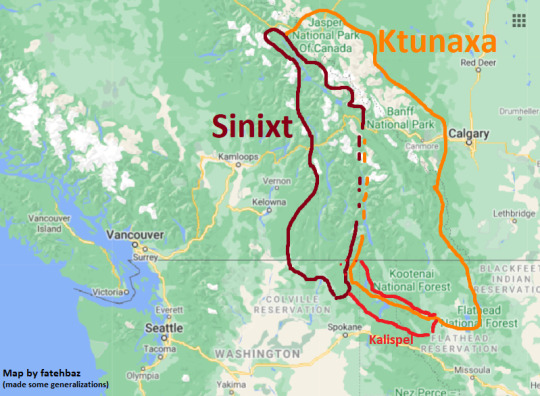
And yes, there are some updates on Zincton from November 2020.
@moss-effect -- I know that you already know this stuff. But for anyone unfamiliar:
The Zincton resort is being constructed only about 70-ish kilometers or so away from where the Jumbo resort was planned. Zincton is also on Ktunaxa territory, as well as traditional land of the Sinixt. Zincton (being built near Valhalla and Goat Range, between Naksup and Kaslo) expects a “grand opening” in December 2021. The project is run by the owner/founder of a local outfitter/recreation company. As of November 2020, BC’s Mountain Resorts Branch is still reviewing the owner’s formal proposal. Zincton sits closer to even more extensive old-growth forest and major protected areas.
Zincton also seems to be a manifestation of that now-classic category: “progressive” settler-colonial entrepreneurs from coastal BC, the Pacific Northwest, and/or Rocky Mountain West are familiar with local rhetoric and therefore elude criticism by rebranding their extractive and development projects as “eco-friendly”. According to The Narwhal (November 2020) the owner/project leader had this to say about the project: “There is a real story here of a proven disruptor facing down the mob to do one last project for the kids and grandkids. … Jobs for locals, a future for families, saving the hospital. Zincton is the Tesla of the ski village business.”
-------
Also, for context: Here’s a post I made about the inland temperate rainforest, its ecology/geography, and its endemic creatures. Here’s a post from June 2020 about the Zincton resort development. Here’s a compilation post with news/timeline/summary and maps describing the extinction of southern mountain caribou in 2019 (southern mountain caribou are a local icon, completely endemic to this region, and are highly endangered; caribou were declared extinct in the contiguous United States in 2019 when the last of the southern mountain caribou were relocated farther north to BC). Here’s a compilation post with news/timeline following the Sinixt case to receive formal recognition from BC/Canada in 2019 and 2020 (much of the rainforest, including the Zincton site, is within Sinixt traditional territory; the Canadian government declared the Sinixt “extinct” in the 1950s).
-------
Location of core cedar-hemlock forest of inland temperate rainforest region, compared with distribution range of the southern mountain caribou:

Photos I took of stream habitat in inland temperate rainforest:
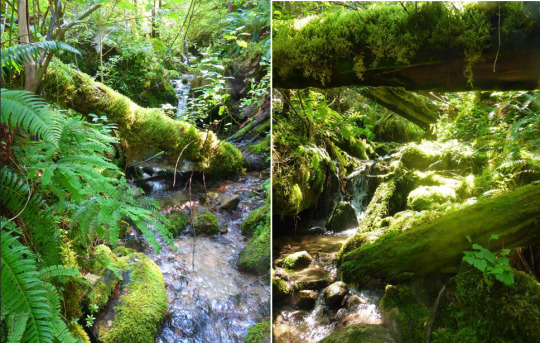
-------
Coincidentally, just a couple of days ago, The Narwhal just released an “explainer” dedicated to the Zincton: Paul Fischer. “Why B.C.’s Zincton resort, the proposed ‘Tesla of ski villages,’ is worrying conservationists.” The Narwhal. 27 November 2020.
Zincton claims that it is a “radical departure from the status quo” and will be a “carbon-zero” resort. But local groups oppose the project, including Wildsight, West Kootenay Eco Society, and locally-famous Valhalla Wilderness Society. (The core of the inland temperate rainforest is sometimes referred to as “Valhalla” or “Caribou Rainforest”.) The project also claims that the resort’s focus on so-called “eco-tourism” is a good way to “grow and replace economic decline,” which you might perceive to be a settler-colonial interpretation of the “value” of the forest and also suggests that the concern here is, of course, making money. From Fischer’s article: ‘In a series of emails with The Narwhal, Harley [the project leader] dismissed environmental concerns. He said impacted grizzly habitats are low quality and categorized the criticism from certain environmental groups as a “copy and paste” campaign motivated by a desire to oppose everything rather than contribute constructively.’
These quotes can be found in the article:







-------
Here’s some other stuff:

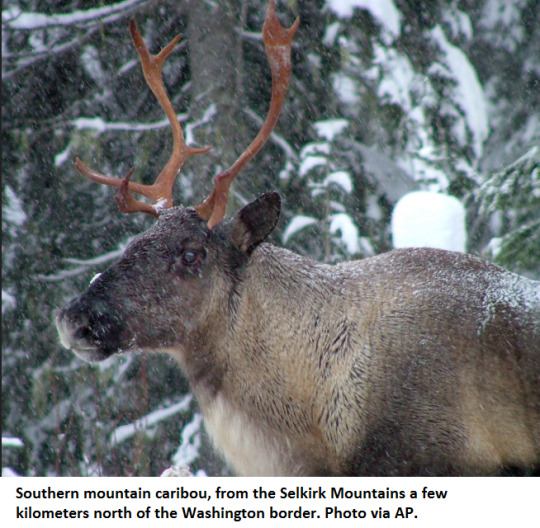

-------
Headlines from the Jumbo resort news:
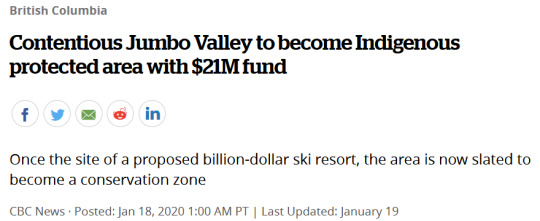

The Sinixt case:

Southern mountain caribou herd decline in the inland temperate rainforest between 1990 and 2018. The Zincton resort will directly affect Purcells South, Central Selkirks, and South Selkirks herd.
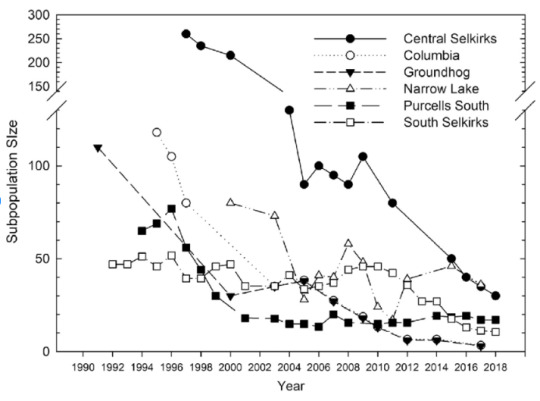

-------
And I want to say that both the Ktunaxa and Sinixt people have recently been undermined, insulted, and dispossessed by BC and development projects in similar ways. Media, educational material, and conservation groups in BC like to point out that the inland temperate rainforest is “globally-unique” (in that it’s really the planet’s only sizable “coastal-type temperate rainforest” existing inland and away from a coast). And you’ll see the inland temperate rainforest described with terms like: prized, treasure, gem, hidden/secret rainforest, etc. And the region is discussed in settler-colonial terms/concepts (”BC’s forgotten rainforest,” “BC’s other rainforest”, “a magnificent carbon cache”, “unparalleled resource”) as if it is the patrimony of the province of BC or Canadian state. Which of course is problematic because it (1) associates the forest’s importance with bioprospecting/scientific extractivism, carbon sequestration, or other metrics of settler-colonial “value,” and also because (2) the province of BC continues to fight very hard against recognizing the land as part of Sinixt territory (after Sinixt people and allies were able to win cases against BC, the province continued to appeal, and this case has now culminated in the October 2020 hearing at the federal Supreme Court, which will soon make a final ruling on whether or not Sinixt people are legally allowed land rights to harvest, travel, etc. within BC).
-------
Here’s a map:
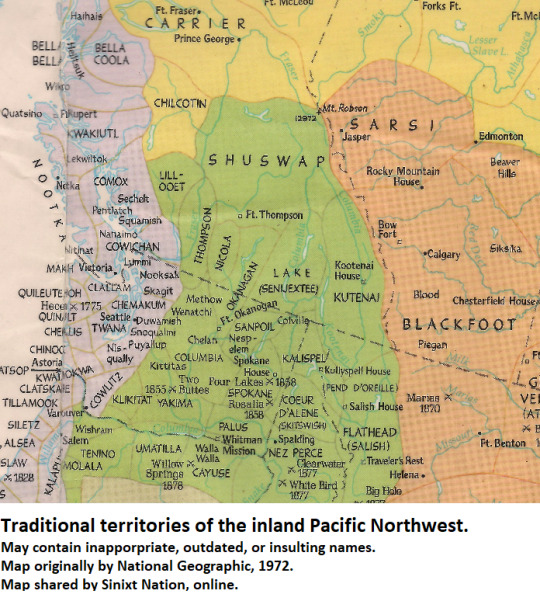
From 2018, there is this book:

In the US, too, parks, like ski resorts, are implicated in Indigenous dispossession.
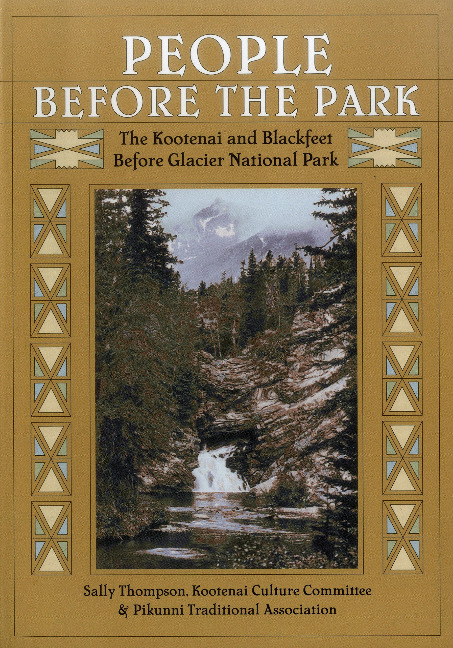
Glacier National Park (at the border of BC, Alberta, and Montana) sits on the edge of the Kootenay and inland temperate rainforest regions. Conservation groups, universities, and other US institutions have taken to calling Glacier part of “the Crown of the Continent” (another possessive/patrimonial term maybe?), a portion of the heavily-glaciated Canadian Rockies that kinda includes Banff and Jasper, too. Glacier National Park is on Ktunaxa and Blackfeet territory. A recently published book that might be interesting: People Before the Park: The Kootenai and Blackfeet Before Glacier National Park. Sally Thompson, Kootenai Cultural Committee, and Piikuni Traditional Association. 2015
Described by Montana Public Radio in 2017: “Step [...] into the world of the Kootenai and Blackfeet peoples, whose traditional territories included the area that is now Glacier National Park. [...] In this book, the Kootenai and Blackfeet tribes share their traditions -- stories and legends, foodways and hunting techniques, games and spiritual beliefs.”
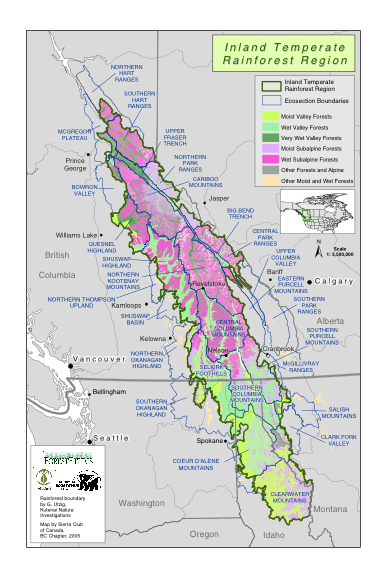
Just a special place.
Thank you for saying something.
292 notes
·
View notes
Text
OCTOBER 2021
THE RIB PAGE
*****
We miss U Charlie Watts!!
*****
The Stones performed at a private party for Patriots owner Robert Kraft of all people. The test run looked like just that. Shark jumped. I am becoming disillusioned.
*****
SNL is back with Owen Wilson as first host of season 47. Kacey Musgraves is the musical guest. Episode 2 will have a ridic choice for host. Halsey will sing. I suppose $ is power with the Kardashians. I could think of about 10 million other people to host but more and more Lorne goes for the shiny object , what he THINKS people want instead of taking risk. Beck Bennett is out.
*****
Is everybody watching the Amber Ruffin Show?? I loved her before but now… I learn so much from her show. Sometimes it takes a comic to get to the real serious shit. For example: Have you heard of drowning towns? Towns like Oscarville, Kowaliga, York hill, Seneca Village, Prentiss and countless other black towns that were drowned out to make lakes for the local whites. Central Park was also made after a black community was erased from history. Development displacement? Alleyway dwelling authority? Even those rabid for history can find out new things everyday. Thanks Amber!!
*****
Bob Woodward and Robert Costa are finally giving us Peril !!!!!! I’ve been waiting!!** I was in political nerd heaven on Sept. 24 when Yamiche hosted Robert, Bob and Weijia Jang on Washington Week. All of my favorite pundits all together at one table, my dream team!!
*****
Iman looked great at the Met Gala!! Other great looks belonged to AOC, Tessa Thompson, Maluma, Helen Lasichanb and Pharrell Williams. Gigi Hadid, Kiki Layne, Ashton Sanders, Hailee Steinfeld, Kehlani, Zoe Kravitz, Michaela Cole, Lili Reinhart, Kate Hudson and Shai Gilgeous- Alexander were great. Whoopi Goldberg seemed a bit off.
*****
Jason Isbell is back with his latest offering, Georgia Blue.
*****
I see a lot of Title Max type establishment are closing down. Are they a thing of the past? Let’s hope.
*****
Law and Order is coming back to NBC for season 21. Dick Wolf will own 2 entire nights of television. Some of the old cast is reported to be returning.
*****
Britney Spears Father was suspended as her conservator.
*****
Timothy Chalamet, Rowan Atkinson, Sally Hawkins and Olivia Coleman will star in Wonka.
*****
The 2022 Super Bowl halftime show will bring us Snoop Dogg, Eminem, Mary J. Blige, Dr. Dre and Kendrick Lamar.
*****
People are doing test runs for school board positions to see if their political ideas will play well for the big leagues. If they don’t seem to work, at least they can sometimes change the rules in their own area.
*****
Joe Rogan got Covid.
*****
Lake Michigan beaches were closed down thanks to a US Steel plant chemical leak.
*****
Is this country the master of endless administrative work? None of us should have been surprised at the red tape that the slowed down the end of the war in Afghanistan.** Uber donated 50k for rides and meals to the Afghans when they arrive.**And why do so many waste taxpayer $ on useless recounts and recalls when people need real help with food and healthcare? They must really hate humanity.
*****
R. Kelly was found guilty of 8 counts of sex trafficking and 1 count of racketeering.
*****
Every gun that is made, every warship launched, every rocket fired signifies, in the final sense, a theft from those who hunger and are not fed, those who are cold and are not clothed. – Dwight D. Eisenhower
*****
Texas has put a law into effect to allow most Texans to carry open without permit or training.
*****
Texas has banned abortion at about 6 weeks. Uber and Lyft will pay drivers legal fees if sued under Texas abortion law. Lyft donated $1mil to Planned Parenthood. ** Look for the ruling in the Mississippi law over Roe V. Wade in June 2022.**Hear us roar!** BTW.. Go Jen Psaki!!!!!!!
*****
They seriously banned plastic straws and abortion before assault rifles? – Eden Dranger
*****
Please stop banning abortions, the last thing the world needs is more Americans. –Sarah Beattie
*****
Women don’t inseminate themselves. Vasectomies are reversible. Should every man have one until he’s deemed financially and emotionally fit to be a Father? – Bradley Whitford
*****
90 year old William Shatner will go to space for Blue Origin.
*****
The Q Anon Shaman pled guilty to a felony for obstructing the Electoral College proceedings. I say 20 years and a $250K fine.** 600 others have been indicted.
*****
Days Alert: The Beyond Salem thing was ridic but it was so great to see some old characters. Days is so great at visiting old family. Who can resist Shane, Austin and Carrie, Billie and the old Kristen? I do wish that Peacock would get their kinks out!! Back to the real Days: Are we smelling an Emmy for Susan Seaforth Hayes and Bill?? ** Good to have Abigail back. It is always fun to wonder which actress and or personality it will be. ** Deidre Hall got her star on the walk of fame.**And just in time for Halloween, the Devil is making a comeback. The end of the year in Salem is always the best!! It is so brave to give the 96 year old man the old switcheroo into the Dark Lord. It was fun to see the grandkids discover Grandma Marlena’s story. Delicious!! Hail Satan!!** It is past time for Tate and Teresa to come back to town. Brady needs to be put in his place. And thanks for the Philip and Chloe flashbacks!!
*****
The breakdown of the vaccinated: 90% of Atheists, 86% Hispanic Catholic, 84% Agnostic, 79% White Catholic, 73% White mainline protestant, 70% Black mainline protestant, 57% white evangelical. 1 in 500 Americans have died of Covid.
*****
So Mike Lindell and Jim Baker have teamed up to sell children’s Bible pillows.** Piers Morgan has returned to the Murdoch organization by joining Fox. That sounds about right.
*****
Please stop saying the vaccine does not have severe side effects, I took my shots and now I’m alive and have to keep working. –Mohand Eishieky
*****
In theatres Oct. 22: The French Dispatch.** October also brings us a new season of Curb your enthusiasm and Oct. 17 will catch us up on Succession. Whew!!!
*****
So people under conservatorship are not free to marry who they want? What?
*****
46% of Americans believe in ghosts.
*****
Simone Biles, Mckayla Maroney and Aly Rasiman testified at the Senate judiciary hearing about the FBI’s handling of accusations against Larry Nassar and it was eye opening!
*****
We wanted a no -nonsense Dem who pushes on and does not puss out. I am a bit surprised to see we have it. There are so many pressing issues that I hope Biden works a bit more on Haiti though.
*****
The National Police Act was passed to celebrate cops. Still no police reform.
*****
John Mulaney and Olivia Munn are going to have a baby.
*****
The Emmy’s were a little different this year with more of a Golden Globe look. Cedric the Entertainer hosted with Reggie Watts as DJ. Lots of minority noms but barely a win. It was a white people night. Ted Lasso had a great night. Mare of Eastown took home a few with Evan Peters, Julianne Nicholson and Kate Winslet. Now, Kate is great but how did Anya Taylor- Joy not walk away with that? Queens Gambit did win a couple and gave the longest speech with the seemingly arrogant director Scott Frank who opened up 2 page acceptance. Categories were tough but I was routing for Renee Elise Goldberry and Bowen Yang but perhaps next year. The people in England who had their own party for all the statues that the Crown won seemed to be having more fun! Hacks won for writing and directing and Jean Smart!! It was nice to see the Norm Macdonald love which was barely mentioned by Lorne but celebrated by John Oliver. Colbert ‘s election night special won as did JB Smoove. Hamilton won and Debbie Allen got the big one. I do not understand why real singers and or musicians have to be there for the in Memoriam. It takes me out of it a bit and concentrates the focus on them. Do they think that people will pay attention more? Do they want to keep the home audience or live audience from the bathroom? My best dressed were Anya Taylor-Joy, Michaela Cole who won for I may destroy you, Jean Smart, Josh O’Connor, Kathryn Hahn, Billy Porter, MJ Rodriguez, Keenan Thonpson, Leslie Odom Jr., Catherine O’Hara, Trevor Noah, Eugene Levy, Keri Russell and Matthew Rhys, Bowen Yang, Anthony Anderson, Leslie Grossman, Amber Ruffin, Allyson Felix, Renee Elise Goldberry, Samira Wiley and Rege- Jean Page. My worst were Sarah Paulson, Gillian Anderson, Beanie Feldstein, Elizabeth Olsen and Aidy Bryant. To me the best part of the show was the enthusiasm of Conan and the way he injected himself into much of the evening .He was the show. Go Conan!!!!!!!!!!!!!!
*****
Next year there must be some Emmys for Sarah Paulson and Cobie Smulders in Impeachment!!!!!
*****
Oh Boy!! The Eyes of Tammy Faye!!
*****
Looking forward to the Electric Life of Louis Wain with Benedict Cumberbatch and Claire Foy.
*****
Abba has a new album!!
*****
Shang Chi is the biggest Labor Day opening with a $71.4 mil opening.
*****
Sen. Amy Klobuchar has announced she has breast cancer.
*****
Is it the 70’s? A streaker ran past the studio of the Today show.
*****
Rascal Flatts Joe Don Rooney was arrested for DUI.** Nicholas Cage was thrown out of a prime rib pace in Vegas after being drunk and disorderly.
*****
Jennifer Eckhart has filed a lawsuit against former Fox news anchor Ed Henry for rape and retaliation after allegedly being handcuffed and beaten.
*****
Scarlett Johansson has settled her Disney lawsuit.
*****
Pete Buttigieg and Chasten had twins they named Penelope Rose and Joseph August.
*****
I noticed a commercial for Dancing with the Stars. Are we onto the E list because I have heard of hardly any of these people. ‘Stars’is really stretching it. And as I post this I see there are some covid issues there as well.
*****
Virgin River was renewed for 2 more seasons.
*****
Trevor Noah is right? Why do they stop giving lollipops to adults at the doctor?
*****
Jon Stewart is back on Apple tv with ‘The problem with Jon Stewart.
*****
Brooklyn 99 had about the best finale (other than Newhart) that I can recall. I had my fingers crossed that Chelsea would be back. Will they honor us like they did in the show and come back for a special about once a year? That would be fucking awesome!!
*****
Don’t expect compliments from an insecure person.- Mr. Pickles
*****
Thousands and thousands of people are in need. Haitian refugees and other immigrants have seen nothing like this what with assassination, a hurricane and earthquake. The Southern border is a mess.** Why does Fox news keep telling refugees the border is open as they sit back and laugh at Biden’s predicament. Spreading false info to intentionally hurt poor, distressed people has no end for them.
*****
Do companies know how fucked up their employment websites are? It is true that some people do not want to work. It is true that people schedule interviews and don’t show up. It is also true that companies have made it so hard to apply that many can’t. I suppose it is easier for them but the poor who may really want to work have a hard time. Paper applications are almost completely gone. The old fashioned way of walking into low paying job sites and finding a connection with a manager rarely exist. Some places only accept texts or have long ridiculous psych tests that a working Mother may not have time for. A Father working many hours already, may not be able to go to the library to get online if they cannot afford a computer. Many websites tell you that there no positions available in your area while there is a huge sign in front of the establishment. Can’t find people to work.. Gee I wonder why?? And treat people with respect once you find them, how about that?
*****
Keep your head up in failure, and your head down in success. –Jerry Seinfeld
*****
Hey.. There was a van air B’n B biz going that got busted. Hey.. The poor need vaca’s too. It is wrong but If they are willing to sleep in a van, why not. I truly think that many do not understand how much people are struggling.
*****
Free coffee day came and went but only a few places really gave you free coffee without rules to govern the promo. Some places wanted to sell you something else and some made you belong to their club. Starbucks held that customers had to come inside for the free cup of Joe, handicapped or not.
*****
One would think the Republicans would run out of $ for recounts but they have deep pockets. Just think how much good they could do for the huddled masses with that scratch.
*****
Sad to lose Mick Brigden, protégé of Bill Graham who managed The Stones and worked with Frampton, Dylan and Santana.** And the comics were very vocal about the loss of Norm Macdonald. He was one of a kind and he will be missed!
*****
R.I.P. Ruth Marx, Lee Scratch Perry, Willard Scott, Jean-Paul Belmondo, Isadore Bleckman, George Wein, Michael K. William,George Holliday, Anthony Johnson, Basil Hoffman, Al Harrington,Willie Garson, Mick Brigden, Tommy Kirk and Norm Macdonald.
3 notes
·
View notes
Text
Septic System Maintenance: Plumb Nerd's Tips

Introduction
Howdy, DIY warriors! Jack Thompson, your Plumb Nerd from Denver, is here to share some practical tips on septic system maintenance. If you're a proud septic system owner and want to keep everything flowing smoothly, you're in the right place. This guide is packed with straightforward advice to help you maintain a healthy septic system and avoid costly issues. Let's dive into the world of septic system care together.
Why Maintain Your Septic System?
Before we jump into the tips, let's quickly understand why maintaining your septic system is crucial: - Prevent System Failure: Regular maintenance prevents issues that can lead to septic system failure and expensive repairs. - Protect Groundwater Quality: Proper care ensures that your septic system doesn't contaminate groundwater, protecting the environment. - Extend System Lifespan: Routine maintenance can significantly extend the lifespan of your septic system.
Plumb Nerd's Tips
Here's your roadmap to becoming a septic system maintenance pro: 1. Regularly Pump the Tank Timing is everything: - How-to: Schedule regular septic tank pumping every 3-5 years, depending on household size and usage. - Why: Prevents sludge buildup, maintaining the tank's efficiency. 2. Be Water-Wise Conservation matters: - How-to: Fix leaks promptly, use water-efficient appliances, and spread out water usage to avoid overwhelming the system. - Why: Excessive water can overload the septic system. 3. Avoid Flushing Non-Biodegradable Items Mind your flush: - How-to: Only flush biodegradable items; avoid flushing non-degradable items like wipes, paper towels, or feminine hygiene products. - Why: Prevents clogs and minimizes strain on the system. 4. Use Septic-Safe Products Choose wisely: - How-to: Opt for septic-safe household products, including toilet paper, detergents, and cleaning agents. - Why: Harsh chemicals can disrupt the balance in the septic tank. 5. Be Cautious with Chemical Drain Cleaners Handle with care: - How-to: Avoid using chemical drain cleaners as they can harm the beneficial bacteria in the septic tank. - Why: Preserves the bacterial balance necessary for system function. 6. Direct Water Away from the Drainfield Mind your landscaping: - How-to: Ensure that rainwater and runoff are directed away from the septic drainfield. - Why: Prevents oversaturation of the drainfield, maintaining its effectiveness. 7. Plant Grass Over the Drainfield Green solution: - How-to: Plant grass over the drainfield to prevent soil erosion and promote optimal absorption. - Why: Grass helps with soil stability and absorption. 8. Avoid Parking or Heavy Structures Over the Drainfield Protect the ground: - How-to: Keep heavy vehicles, structures, or equipment away from the drainfield area. - Why: Prevents soil compaction and damage to the drainfield. 9. Inspect and Maintain the Distribution Box Check the junction: - How-to: Periodically inspect and maintain the septic system's distribution box for proper function. - Why: Ensures equal distribution of effluent to the drainfield. 10. Monitor Vegetation Near the Tank and Drainfield Watch your plants: - How-to: Avoid planting trees or shrubs with aggressive roots near the septic tank or drainfield. - Why: Prevents root intrusion and potential damage to the system. 11. Schedule Professional Inspections Expert eyes: - How-to: Periodically, hire a professional to inspect your septic system for signs of issues. - Why: Experts can detect problems early, preventing major repairs. 12. Educate Household Members Spread awareness: - How-to: Inform everyone in your household about septic system care and best practices. - Why: Encourages a collective effort to preserve the system.
Conclusion
There you have it, DIY champs! Tips for maintaining your septic system, delivered by Jack Thompson, your Plumb Nerd. If you ever need more DIY wisdom, head over to plumbnerd.com. Now, go keep that septic system in top-notch condition. Happy maintaining! Read the full article
0 notes
Text
Oscar Stanton De Priest

Oscar Stanton De Priest (March 9, 1871 – May 12, 1951) was an American politician and civil rights advocate from Chicago. A member of the Illinois Republican Party he was the first African American to be elected to Congress in the 20th century. During his three terms, he was the only African American serving in Congress. He served as a U.S. Representative from Illinois' 1st congressional district from 1929 to 1935. De Priest was also the first African-American U.S. Representative from outside the southern states and the first since the exit of North Carolina representative George Henry White from Congress in 1901.
Born in Alabama to freedmen parents, De Priest was raised in Dayton, Ohio. He studied business and made a fortune in Chicago as a contractor, and in real estate and the stock market before the Crash. A successful local politician, he was elected to the Chicago City Council in 1914, the first African American to hold that office.
In Congress in the early 1930s, he spoke out against racial discrimination, including at speaking events in the South; tried to integrate the House public restaurant; gained passage of an amendment to desegregate the Civilian Conservation Corps, one of the work programs under President Franklin D. Roosevelt's New Deal; and introduced anti-lynching legislation to the House (it was not passed because of the Solid South Democratic opposition). In 1934, De Priest was defeated by Arthur W. Mitchell, the first African American to be elected as a Democrat to Congress. De Priest returned to Chicago and his successful business ventures, eventually returning to politics, when he was again elected Chicago alderman in the 1940s.
Early life
De Priest was born in 1871 in Florence, Alabama, to freedmen, former slaves of mixed race. He had a brother named Robert. His mother, Martha Karsner, worked part-time as a laundress, and his father Neander was a teamster, associated with the "Exodus" movement. After the Civil War, thousands of blacks left continued oppression by whites in the South by moving to other states that offered promises of freedom and greater economic opportunities, such as Kansas. Others moved later in the century.
In 1878, the year after Reconstruction had ended and federal troops been withdrawn from the region, the De Priests left Alabama for Dayton, Ohio. Violence had increased in Alabama as whites had tried to restore white supremacy: the elder De Priest had to save his friend, former U.S. Representative James T. Rapier, from a lynch mob, and a black man was killed on their doorstep. The boy Oscar attended local schools in Dayton.
Career
Business
De Priest went to Salina, Kansas, to study bookkeeping at the Salina Normal School, established also for the training of teachers. In 1889 he moved to Chicago, Illinois, which had been booming as an industrial city. He worked first as an apprentice plasterer, house painter, and decorator. He became a successful contractor and real estate broker. He built a fortune in the stock market and in real estate by helping black families move into formerly all-white neighborhoods, often ones formerly occupied by ethnic white immigrants and their descendants. There was population succession in many neighborhoods under the pressure of new migrants.
Politics
From 1904 to 1908, De Priest was a member of the board of commissioners of Cook County, Illinois.
De Priest was elected in 1914 to the Chicago City Council, serving from 1915 to 1917 as alderman from the 2nd Ward, on the South Side. He was Chicago's first black alderman. In 1917 De Priest was indicted for alleged graft and resigned from the City Council. He hired nationally known Clarence Darrow as his defense attorney and was acquitted. He was succeeded in office by Louis B. Anderson.
In 1919, De Priest ran unsuccessfully for alderman as a member of the People's Movement Club, a political organization he founded. In a few years, De Priest's black political organization became the most powerful of many in Chicago, and he became the top black politician under Chicago Republican mayor William Hale Thompson.
In 1928, when Republican congressman Martin B. Madden died, Mayor Thompson selected De Priest to replace him on the ballot. He was the first African American elected to Congress outside the South and the first to be elected in the 20th century. He represented the 1st Congressional District of Illinois (which included The Loop and part of the South Side of Chicago) as a Republican. During the 1930 election, De Priest was challenged in the primary by noted African-American spokesperson, orator, and Republican Roscoe Conkling Simmons. De Priest defeated Simmon's primary challenge and won the general election afterward. During De Priest's three consecutive terms (1929–1935), he was the only black representative in Congress. He introduced several anti-discrimination bills during these years of the Great Depression.
DePriest's 1933 amendment barring discrimination in the Civilian Conservation Corps (CCC), a program of the New Deal to employ people across the country in building infrastructure, was passed by the Senate and signed into law by President Franklin D. Roosevelt. His anti-lynching bill failed due to opposition by the white conservative Democrats of the Solid South, although it would not have made lynching a federal crime. (Previous anti-lynching bills had also failed to pass the Senate, which was dominated by the South since its disenfranchisement of blacks at the turn of the century.) A third proposal, a bill to permit a transfer of jurisdiction if a defendant believed he or she could not get a fair trial because of race or religion, was passed by a later Congress.
Civil rights activists criticized De Priest for opposing federal aid to the poor. Nevertheless, they applauded him for making public speeches in the South despite death threats. They also praised De Priest for telling an Alabama senator he was not big enough to prevent him from dining in the private Senate restaurant. (Some Congressmen ate in the Senate restaurant to avoid De Priest, who usually ate in the Members Dining Room designated for Congressmen.) The public areas of the House and Senate restaurants were segregated. The House accepted that De Priest sometimes brought black staff or visitors to the Members Dining Room, but objected when he entertained mixed groups there.
De Priest defended the right of students of Howard University, a historically black college in Washington, D.C., to eat in the public section of the House restaurant and not be restricted to a section in the basement near the kitchen, used mostly by black employees and visitors. He took this issue of discrimination against the students (and other black visitors) to a special bipartisan House committee. In a three-month-long heated debate, the Republican political minority argued that the restaurant's discriminatory practice violated 14th Amendment rights to equal access. The Democratic majority skirted the issue by claiming that the restaurant was a private facility and not open to the public. The House restaurant remained segregated through much of the 1940s and maybe as late as 1952.
In 1929, De Priest made national news when First Lady Lou Hoover invited his wife, Jessie De Priest, to a traditional tea for congressional wives at the White House.
De Priest appointed Benjamin O. Davis Jr. to the United States Military Academy at a time when the only African-American line officer in the Army was Davis's father.
By the early 1930s, De Priest's popularity waned because he continued to oppose higher taxes on the rich and fought Depression-era federal relief programs under President Roosevelt. De Priest was defeated in 1934 by Democrat Arthur W. Mitchell, who was also African American. After returning to his businesses and political life in Chicago, De Priest was elected again to the Chicago City Council in 1943 as alderman of the 3rd Ward, serving until 1947. He died in Chicago at 80 and is buried in Graceland Cemetery.
Personal life
Oscar married the former Jessie L. Williams (c. 1873 – March 31, 1961). They had two sons together: Laurence W. (c. 1900 – July 28, 1916), who died at the age of 16 and Oscar Stanton De Priest, Jr. (May 24, 1906 – November 8, 1983) A great-grandson of Oscar De Priest, Jr., Philip R. DePriest, became the administrator of his estate after his grandmother's death in 1992. This included his great-grandfather's Oscar Stanton De Priest House, now a National Historic Landmark, which still held his locked political office. This had not been touched since about 1951. This great-grandson has been working to restore the office and house, and assessing the political archives—"a veritable treasure trove."
Legacy and honors
The Oscar Stanton De Priest House in Chicago, at 45th and King Drive, has been designated as a National Historic Landmark and city landmark.
See also
List of African American firsts
List of African-American United States Representatives
Oscar Stanton De Priest House
Jessie De Priest
References
Bibliography
Day, S. Davis. "Herbert Hoover and Racial Politics: The De Priest Incident". Journal of Negro History 65 (Winter 1980): 6-17
Nordhaus-Bike, Anne. "Oscar DePriest lived Pisces's call to service, unity." Gazette, March 7, 2008.
Olasky, Martin. "History turned right side up". WORLD magazine. 13 February 2010. p. 22.
Rudwick, Elliott M. "Oscar De Priest and the Jim Crow Restaurant in the U.S. House of Representatives". Journal of Negro Education 35 (Winter 1966): 77–82.
External links
United States Congress. "Oscar Stanton De Priest (id: D000263)". Biographical Directory of the United States Congress.
Search for National Historic Landmark: Oscar De Priest House, National Park Service
“DE PRIEST, Oscar Stanton”, History, Art & Archives, U.S. House of Representatives
Shelley Stokes-Hammond, Biographical sketch: "Pathbreakers: Oscar Stanton DePriest and Jessie L. Williams DePriest", The White House Historical Association
"The DePriest Family Legacy", Video Interview/YouTube, White House Historical Association
5 notes
·
View notes
Link
“I got grabbed and detained by cops this morning, but then released (thanks to Samuel and Brenda for being there to de-escalate the cops and for sticking around) for apparently inciting a vehemently anti-refugee crowd.
I was on my way to work and saw tons of banners claiming Trudeau is responsible for the murder of Marissa Shen. For those who don’t know, Marissa Shen was a 13-year old girl who was murdered in Burnaby in 2017. Her murder was devastating, and particularly so in Burnaby (close to my extended family’s place) as it was in Central Park where so many families, especially immigrant families, congregate. A few months ago Ibrahim Ali was charged, and the media has been hyper-focused on the fact that he arrived to Canada as a church-sponsored refugee from Syria.
This has had huge ripple effects. Faith Goldy has been picking up on this. Laura Thompson, who is running to be school trustee as a white supremacist anti-SOGI candidate, was a previous similar rally. I am obviously not a fan of Trudeau, but he’s become the target for letting in ‘too many refugees’ by the fascist white supremacist right by people like Goldy and Thompson and Ibrahim’s migration background - which should not be relevant- is now part of their arsenal. This is part of a frightening global trend with escalating white supremacist rhetoric and policies against refugees esp Muslim refugees in Europe.
I walked by the rally and started talking to a group of people about why they were focused on the refugee process, and explaining how the refugee process is already too stringent, expressing my concern that this fixation on his refugee background has contributed to a strong overall anti-refugee climate (and i know this concretely because i have been talking to progressive churches about sanctuary for a family who are facing deportation and the churches are worried about the hostility and can’t take on sanctuary at this moment), and why weren’t we talking about violence against women and girls and vulnerability to violence as a priority instead.
The conversation is heated and I keep getting baited about ‘supporting murderers’ and my own personal background (am i a mom, a canadian, my ethnicity and religious background)
As soon as media cameras noticed the conversation, the whole rally surrounds me, I can’t physically leave, and they start yelling and baiting me with: (I probably dont have the order of everything right coz it was intense and all in all was around 20 mins or so)
“no bail for murderers’ ’ you support murderers’.”
I respond that I work and am connected to a community reeling from the grief of serial murderers.
“how do you know the pain of a mother, you probably aren’t a mother.”
Yes I am
“Are you a Muslim”
No I am Sikh, but so what if I was.
“Sikhs have created so many religious problems too”
Wow. That’s a fcked up thing to say.
I start to respond more fully to that one, but then loud chanting begins:
“We don’t want a refugee flood.” “More screening for refugees”
There isn’t a flood, Canada accepts less than 0.01 percent of the worlds’ refugees. And aren’t you here for some reason of your own? (the crowd is entirely Chinese folks).
“Are you a refugee? We are hard working Canadian citizens”
A guys spits on me and at me, so I can’t even respond to that one. I move back, the cops move in. Cops tell me I am obstructing, I start to debate with the cops about how that is even possible given that i am surrounded and its public space, then they tell me I am inciting a crowd - a crowd that is literally surrounding me and chanting over me about 'Don’t support murderers. No bail. Screen refugees’.
More happened in between and the cops grab me, but I was tearing and close to crying at the end. Not from debate or confrontation - that is familiar though never comfortable - but because this is the brutal fucking reality of some immigrants with deeply conservative values that align with capitalism and white supremacy, of working with and supporting women dealing with daily endemic violence and to have a horrific murder of a young girl suddenly become about everything *except* violence against women and girls, of being forced to defend a government policy that is so abyssal to begin with, of not knowing if this one family - or any other family - will be able to get church sanctuary anytime soon because of this huge chill effect, of being overwhelmed by the number of people i know who are in detention right now facing deportation who have a right to be free.
At the end, one woman comes over to talk for bit, we have a decent conversation about the problematic anti-refugee rhetoric and how suddenly the conversation has pivoted to refugees when before he was charged there is some discussion about increased safety for women and girls in the area - which was a more relevant and necessary conversation. We hug and she gives me a flower and asks if I will attend her chinese womens book club that has been talking about this. I say yes and she gets my number. Samuel Holmes graciously encourages her to see the big picture too.
But the intensity and immensity has me shook and I feel even more frustrated at how deep multi racial, cross community, racial justice work and relations is sorely lacking in our city.“
–
Submitted by @theslightestwords.
144 notes
·
View notes
Text
My response to the Government of Ontario’s proposed Cormorant cull

This is what I submitted as a response to the Ontario government’s proposal for a cull of double-crested cormorants in the province. I am proud of what I’ve done here, and maybe this can open some eyes to the prejudice levelled at these magnificent animals, and the gross unfairness of it.
I’ve been in love with these birds since I got the rare and exceptional honour to hold a young one during a banding expedition a few years ago. We’d ventured to an island in Lake Huron, just a few rocks, some grass and a spindly bush poked above the waterline. And on this island a small colony of Cormorants, maybe 50 or 60 pairs, nested beside and even smaller colony of great blue herons. I left that day feeling like my first child had been born ... admittedly, a grey down-covered one.
The proposal can be found here: https://ero.ontario.ca/notice/013-4124
My response is below the fold. Please enjoy, and let me know what you think!
Biases
I believe it is important to state my biases before stating my position, so you know where I’m coming from. I am not affiliated with any organization, though I have read a number of responses to this proposal. I am not a hunter, though I do not have a problem with hunting as long as the hunter seeks to use as much of the animal hunted as he or she is able. I am not an animal rights activist, but I believe in conservation, ecology and evolution. I am not a birder, though I do enjoy birding when I get the chance to do it every couple of years. I am not a scientist, but I am a fan of science.
Reasons for the Proposal
The MNRF proposal points out that cormorant populations “declined significantly in the Great Lakes from the 1950s to the 1970s primarily due to environmental contaminants affecting reproduction,” (ERO) and that cormorant populations have rebounded since, and have achieved what appears to be a stable population. That has to be one of the great conservation success stories, isn’t it? So, what’s the problem?
The MNRF proposal also states concerns from “some groups (commercial fishing industry, property owners) and individuals” (ERO) about the impact of cormorant populations on fish and other species populations, island forest habitats, and aesthetics.
Other respondents (Kroc, others in Further Reading) have pointed out that there is no scientific evidence of cormorants impacting fish populations. In fact, since cormorants are a native species, their relationship with their native prey species is balanced by natural ecological processes. In fact, cormorants, being opportunistic with regards to their prey, makes them an important part of any strategy to manage invasive fish species.
So, without knowing what the “other species” are, that leaves the island forest habitats and aesthetics reasons, which are really the same thing, aren’t they? What happens to the trees in arboreal cormorant colonies doesn’t look good. The trees are killed by the nesting birds, leaving guano covered skeletons. But, this happens locally. Normally, the cormorants that nest in a given location return to that location, year after year. If a colony is successful, then new trees next to the old ones might get killed as new nests are established. But in a stable colony, the number of dead trees will not change from year to year. It’s important to point out that this is a natural, native process, and part of the evolutionary processes that act on the trees as well as the cormorants. Labelling a natural process as ugly is grossly anthropocentric.
Method of the Cull
The MNRF proposes to utilize the small game hunters of Ontario to engage in what is ostensibly an open, unrestricted hunt of cormorants. The proposed March to December season is broader than the birds are present in the province. The 50 birds a day limit (with no hold limit) is practically an invitation to shoot as many birds as the hunter wants. This is reckless enough to allow Ontario hunters to easily wipe out all cormorants in Ontario in a single season. For example, if the Ontario Federation of Anglers and Hunters 100,000 members (OFAH) shot an average of 2 ½ birds each, they could wipe out the approximately 250,000 cormorants in Ontario (Kroc). Even if the proposal is amended to restrict the hunt to times outside when cormorants are reproducing (i.e., early spring and fall, as the OFAH proposes), the potential to wipe out the adult population of cormorants in Ontario in a single season with any kind of hunter-based cull remains.
Despite the dire potential of this plan, I believe that an ethically self-interested hunter, when presented with the reality of the relative inedibility of cormorant flesh, won’t bother to spend the cost of a shell and the effort required to set out to shoot and kill even one bird. This would be fine if all the hunters in Ontario are ethically self-interested, which I doubt, considering the OFAH’s largely supportive response to the proposal.
The OFAH, in their response to this proposal, compares cormorant populations to that of snow geese, and by doing that suggests that the proposed daily limits on cormorants is reasonable compared to the 20/day limit on snow geese (50/day in the Hudson/James Bay area) (OFAH), stating that the daily limits on snow geese have yet to have any real impact on the populations of snow geese. This is misleading. The North American population of lesser snow geese is estimated to be 15 million individuals (DU). This dwarfs the population of cormorants. Which seems to beg the question, is a quarter million individuals really an indication of an out-of-control population?
Anecdotal Cautionary Tale
In 2015, the US Army Corps of Engineers began a campaign to control the population of cormorants that nested on East Sand Island at the mouth of the Columbia River near Astoria, OR. This colony was home to more than 16,000 cormorants, the largest in North America at the time, and represented approximately 40% of the cormorant population west of the Rockies. The Corps oiled the eggs in 6 thousand nests and shot more than 5 thousand birds over the following year. In mid-May of 2016, the colony experienced a complete collapse; 16,000 cormorants abandoned their nests and the eggs in them in a single day. Only a few hundred birds returned to the island in 2017. The rest, it is assumed, spread up-river and established new colonies (CBD).
This case illustrates one, probably unintended, consequence if this, or even an amended cull, is enacted: colony abandonment. Without the cull, cormorants will return to the colonies they went to the previous year. With a stable population of cormorants in Ontario, these colonies will not change, nor will new colonies likely be established. However, if even one colony is abandoned, new colonies will be established to replace it the following year. So, if aesthetics is really a valid reason (perhaps the only potentially valid, if morally questionable, reason left after the other ones have been demonstrated scientifically to be invalid), instigating the proposed cull will very likely result in more colonies being established.
The Real Reason?
The East Sand Island colony of cormorants used to be the largest in North America. Now that honour belongs to the colony in Tommy Thompson Park. That number of cormorants positioned next door to millions of people must look like cormorant populations are completely out-of-control. It’s natural for humans to look at a thing and assume that all other things like it are the same. In this case, however, humans would be wrong. The colony in Tommy Thompson Park is big, bigger than the East Sand Island colony ever was. The damage to the forest of the park is easily visible from various yacht clubs, Cherry Beach and the Toronto Islands. Rather than being celebrated for the amazing feat of nature that the colony represents, people complain about the dead, unsightly trees.
I’m certain the OFAH would also back down from its position, once they can be shown that cormorants not only do not affect fish stock levels, but are a part of the natural life-cycle of those fish, increasing the evolutionary viability of those species. A cormorant colony should be a welcome sight to an angler, since its presence indicates a thriving fish population, for without the fish, there wouldn’t be a colony.
An Alternative Proposal
The scapegoating of native species is an old world, imperial, father-knows-best practice. There is no scientific evidence to support the cull, or the reasons given for it. Yet, the stereotype of cormorants as fish guzzling monsters persists. Which is strange, since there are many different piscivorous bird species in Ontario. Is the prejudice because cormorants are black? Is it because of their unsightly tree nesting colonies? Regardless, it is unfairly bestowed.
I suggest, as an alternative to the proposed cull, an education program aimed at the individuals and groups that believe that cormorants are pests. Present them with the research on the lack of impact of cormorant populations on fish stock levels. Talk about evolutionary and ecological processes and the web of predation that sustains the dynamic populations of native species, stabilizing their populations over time. And, especially, make sure they realize the conservation miracle that allowed cormorant populations to recover after DDT ceased to be used. And maybe statements about how cormorant populations have exploded since the 1970s will said only in celebration of how humans saved cormorants from the brink of extinction.
Cited Sources
ERO: Ministry of Natural Resources and Forestry, “Proposal to establish a hunting season for double-crested cormorants in Ontario”, https://ero.ontario.ca/notice/013-4124, downloaded 2019-01-03.
Kroc: Edward Kroc, “The Government of Ontario proposes a Double-crested Cormorant hunt that could easily eradicate the species from the Great Lakes in a single year”, https://ekroc.weebly.com/blog/the-government-of-ontario-proposes-a-double-crested-cormorant-hunt-that-could-easily-eradicate-the-species-from-the-great-lakes-in-a-single-year, downloaded 2019-01-03.
OFAH: Lauren Tonelli, “ERO Number 013-4124: Proposal to establish a hunting season for double-crested cormorants in Ontario”, Ontario Federation of Anglers and Hunters, https://www.ofah.org/wp-content/uploads/2018/12/ERO-013-4124-cormorants-002.pdf, downloaded 2019-01-03.
DU: Dale D. Humburg, “Light Goose Dilemma: Despite increased harvests, populations of these Arctic-nesting geese continue to grow”, Ducks Unlimited, http://www.ducks.org/conservation/national/light-goose-dilemma, downloaded 2019-01-03.
CBD: “Video Highlights Federal Agencies' Relentless Slaughter of Oregon Cormorants”, https://www.biologicaldiversity.org/news/press_releases/2018/oregon-cormorants-04-05-2018.php, downloaded 2019-01-03.
Further Reading
G. Fraiser, “Proposed cormorant hunt Dec 2018”, http://gsfraser.blog.yorku.ca/research/conservation/proposed-cormorant-hunt-dec-2018/, downloaded 2019-01-03.
Natalie Nanowski, “Not many people like cormorants, but should hunters be allowed to kill 50 birds per day?”, CBC, https://www.cbc.ca/amp/1.4933928, downloaded 2019-01-03.
Christian Paas-Lang, “Ontario government proposes hunting season for cormorants”, Globe and Mail, https://www.theglobeandmail.com/amp/politics/article-ontario-government-proposes-hunting-season-for-cormorants/, downloaded 2019-01-03.
Kate Harries, “Tories’ plan for cormorants is unethical”, Toronto Star, https://www.thestar.com/opinion/letters_to_the_editors/2018/12/12/tories-plan-for-cormorants-is-unethical.html, downloaded 2019-01-03.
Mark McNeil, “Nature not bullets should control cormorants, McMaster biologist says”, Hamilton Spectator, https://www.thespec.com/news-story/9059210-nature-not-bullets-should-control-cormorants-mcmaster-biologist-says/?fbclid=iwar2j2jjoa0fnoj2yfiovidsng417mob7rh6ixlbpdeea7am2__4aqpksvxy&utm_source=foca+elert+december+2018&utm_campaign=elert+dec5+2018&utm_medium=email, downloaded 2019-01-03.
Bird Studies Canada response, “Response to Proposed Hunting Season for Cormorants in Ontario”, https://www.birdscanada.org/news/response-to-proposed-hunting-season-for-cormorants-in-ontario, downloaded 2019-01-03.
Angela Brooks, “Re: MNRF Proposal to Allow Open Season Hunting on Double-crested Cormorants”, Toronto Ornithological Club, https://toc.wildapricot.org/resources/Documents/DCCO%20Letter%20to%20MNRF.pdf, downloaded 2019-01-03.
Ontario Field Ornithologists (OFO) Response to ERO 013-4124. Document emailed as PDF.
4 notes
·
View notes
Photo

Forest stream at Thompson Park Conservation Area (by me)
#forest#trees#stream#creek#wetlands#summer#Thompson Park Conservation Area#Monroe Township#Middlesex County#New Jersey#mine
19 notes
·
View notes